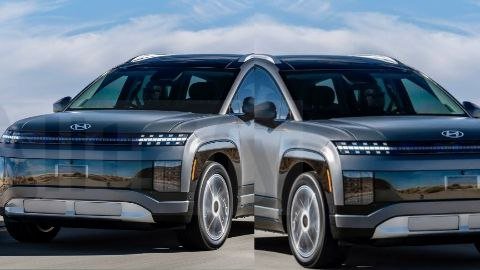As the automotive industry increasingly pivots towards sustainability, Hyundai is positioning itself as a key player in the electric vehicle (EV) landscape. At the Bharat Mobility Global Expo 2025, the company is set to unveil its upcoming electric models, reflecting a robust commitment to electrification. This event is particularly significant as it marks the introduction of several innovative electric vehicles tailored for the Indian market, demonstrating Hyundai’s strategy to meet the growing demand for sustainable transportation solutions.
Table of Contents
Hyundai’s Electric Future
Among the highly anticipated electric vehicles is the Creta Electric, which is expected to resonate with consumers familiar with the brand’s popular Creta SUV. This model aims to cater to the increasing preferences for electric SUVs in India, combining Hyundai’s legacy of reliability with advanced electric technology. The introduction of Creta Electric aligns with the company’s broader initiative to offer diverse options within the EV segment, enhancing accessibility for potential buyers and supporting the transition to greener alternatives.
In addition to the Creta Electric, Hyundai will also showcase the globally recognized Ioniq 9, known for its cutting-edge design and high-performance capabilities. This model is a testament to Hyundai’s innovation prowess, promising features that cater to both luxury and practicality. Alongside it, the Staria MPV will highlight Hyundai’s versatility in the electric domain, targeting families and businesses alike who seek eco-friendly yet spacious travel solutions.
Hyundai’s extensive rollout of these electric models at the 2025 Auto Expo signifies a pivotal moment in the company’s journey towards a sustainable automotive future. The company’s proactive approach indicates a long-term vision committed to electrification, paving the way for a promising transformation of the Indian automotive landscape.
Hyundai Creta Electric: Key Features and Specifications
The Hyundai Creta Electric is poised to make a significant impact in the electric vehicle market, with an anticipated launch date aligning with the 2025 Auto Expo. This electric version of the popular Creta will maintain the essence of its predecessor, closely resembling the internal combustion engine variant in overall design. However, it will feature distinctive changes that highlight its electric nature. A prominent blanked-off grille will set the vehicle apart, along with newly designed alloy wheels which provide a modern aesthetic.
Inside the Hyundai Creta Electric, the cabin is expected to showcase advanced technology and innovative design elements. The introduction of a large touchscreen infotainment system will ensure that drivers and passengers have access to a user-friendly interface, with seamless smartphone connectivity options. This technological advancement emphasizes Hyundai’s commitment to integrating modern conveniences into the driving experience.
Safety remains a top priority for the Creta Electric, as it is designed to meet rigorous safety standards. The expected inclusion of multiple airbags, advanced driver-assistance systems (ADAS), and a robust chassis will provide peace of mind for both drivers and passengers alike. These features reinforce Hyundai’s dedication to creating vehicles that prioritize safety without compromising on performance.
When it comes to performance, the Creta Electric is anticipated to be equipped with various battery options, catering to diverse consumer needs. The potential for different ranges will allow buyers to select a model that aligns with their lifestyle, whether daily commuting or longer journeys. This flexibility in battery specifications positions the Creta Electric as a versatile choice in the growing EV landscape.
As the launch approaches, consumers can expect to see how Hyundai marries its traditional design language with state-of-the-art technology, ultimately delivering an electric vehicle that isn’t just a replacement but an enhancement of the beloved Creta lineup.
Pricing and Market Position of the Creta Electric
The Hyundai Creta Electric is anticipated to be a significant entrant in the Indian electric vehicle (EV) market, with an expected starting price of around Rs 17 lakh. This pricing strategy aims to position the Creta Electric competitively against established rivals such as the Tata Curvv EV and the MG ZS EV. The pricing is crucial in influencing consumer choices, particularly in a segment where budget constraints are a significant consideration for buyers.
As the automotive market in India continues to shift towards electrification, the Creta Electric is poised to attract a diverse customer base, from environmentally conscious consumers to those seeking advanced technology and features. The electric variant of the popular Creta, which has already made a mark in the SUV segment, is expected to leverage the brand’s established reputation for reliability and performance.
In terms of market positioning, the Creta Electric aims to offer a compelling blend of features, range, and driving experience that caters to the growing demand for electric vehicles in urban settings. Competitors like the Tata Curvv EV and MG ZS EV have already established themselves, making it essential for Hyundai to differentiate its offering. The Creta Electric may do so through superior battery technology, enhanced connectivity features, and a focus on safety, helping it stand out in a crowded marketplace.
The expected pricing aligns well with the features and specifications that consumers are likely to seek in an EV, such as a substantial driving range, quick charging capabilities, and modern infotainment systems. By strategically positioning the Creta Electric within this competitive landscape, Hyundai appears ready to not only attract buyers but also bolster its market share in the rapidly evolving electric vehicle sector in India.
Exploring the Hyundai Ioniq 9: Specifications and Design
The Hyundai Ioniq 9 is poised to revolutionize the electric vehicle market with its striking design and advanced specifications. As a significant addition to Hyundai’s electric vehicle portfolio, the Ioniq 9 showcases a bold commitment to innovation. This model is characterized by its modern aesthetic, featuring bold lines, an aerodynamic silhouette, and a distinctive front fascia that exudes a futuristic feel. The three-row seating setup adds practicality and comfort for families, catering to a growing demand for versatile electric vehicles.
Performance-wise, the Ioniq 9 is expected to offer multiple trims, allowing consumers to select a version that meets their performance requirements and budget. The vehicle may be available in both single and dual-motor configurations, providing choices that enhance traction and driving dynamics. Additionally, the release of all-wheel-drive variants is anticipated, which will be particularly appealing to those living in areas with varying terrain and weather conditions.
Battery specifications will play a vital role in the Ioniq 9’s performance. Industry speculation suggests that it will feature a large-capacity battery pack, allowing for an impressive electric range that will rival competitors in the same segment. The integration of cutting-edge fast-charging technology may also be included, enabling swift recharging times that enhance convenience for drivers. Moreover, as Hyundai continues to innovate, it is likely that the Ioniq 9 will include various technological advancements such as updated infotainment systems and robust driver-assistance features.
Globally, the Ioniq 9 is expected to launch following precedents set by its predecessor models, carving out its niche within the electric vehicle market. With its blend of performance, design, and advanced features, Hyundai aims to position the Ioniq 9 as a formidable player in the increasingly competitive EV landscape.
Interior Features and Technological Innovations of the Ioniq 9
The Ioniq 9 presents an exceptional interior, characterized by a contemporary dual-tone theme that adds a layer of sophistication to its overall aesthetic. This design approach not only enhances the visual appeal but also creates an inviting atmosphere for both the driver and passengers. The seamless integration of color schemes showcases Hyundai’s commitment to modern automotive design.
Centrally located within the cabin is an advanced display configuration featuring a large infotainment screen that complements the vehicle’s digital gauge cluster. This setup offers users an intuitive interface to access navigation, media, and vehicle settings while ensuring minimal distraction. The high-resolution graphics and responsive touch capabilities enhance user interaction, making it a pleasure to operate during journeys.
Seating arrangements within the Ioniq 9 are crafted with passenger comfort in mind. The vehicle boasts spacious seating that can accommodate up to five occupants comfortably. The seats are designed with premium materials, providing ample support and ensuring a relaxing experience even on long drives. Notably, the front seats are equipped with electric adjustment features, allowing the driver and passenger to find their optimal seating position effortlessly.
Moreover, the reclining capabilities of the Ioniq 9’s seats contribute significantly to passenger relaxation. This feature allows occupants to unwind during travel, catering to both comfort and convenience. With an emphasis on ergonomics, the cabin space is thoughtfully planned to reduce fatigue, blessing passengers with a cohesive journey experience.
The technological innovations incorporated into the Ioniq 9 extend beyond mere aesthetics. A range of smart features, including voice recognition for navigation and audio control, further elevates the driving experience. These elements work harmoniously to provide a blend of innovation, comfort, and style, solidifying the Ioniq 9 as a formidable contender in the electric vehicle market.
The Hyundai Staria MPV: Features and Market Potential
The Hyundai Staria MPV stands out in the increasingly competitive multi-purpose vehicle (MPV) segment, boasting a design that strikes a harmonious balance between modern aesthetics and practicality. Unlike traditional MPVs, the Staria exudes a futuristic look characterized by its smooth contours and sleek silhouette, which not only enhances its visual appeal but also contributes to improved aerodynamics. This innovative design approach is underscored by its spacious cabin, which emphasizes comfort and convenience for families and larger groups.
Accommodating up to eight passengers, the Staria is engineered with versatility in mind. The flexible seating arrangements allow for various configurations, whether for a family road trip or transporting cargo. The interior space is designed for optimal comfort, equipped with premium materials and advanced technology features, including a state-of-the-art infotainment system and driver-assistance technologies. This positioning as a family-oriented vehicle aligns with the growing market demand for spacious, reliable, and feature-rich MPVs.
In terms of specifications, the Staria shares several features with the popular Hyundai Creta, indicating a common lineage in Hyundai’s design philosophy. However, the Staria distinguishes itself with its unique offerings tailored for larger families or group travel, such as increased legroom, larger windows for better visibility, and convenient storage solutions throughout the vehicle. Additionally, its electric variant is expected to leverage advancements in Hyundai’s electric vehicle technology, which could positively impact its market potential.
With the increasing consumer shift toward eco-friendly transportation, the Hyundai Staria MPV’s entrance into the market holds significant promise. Its appealing combination of modern design, capacity, and advanced features positions it to meet the evolving needs of families and community-oriented users, underscoring its potential as a key player in the Hyundai lineup.
Safety Features across Hyundai’s Electric Range
Hyundai has consistently prioritized safety across its electric vehicle lineup, reflecting its commitment to passenger protection and vehicle reliability. The Ioniq 9 and Staria MPV, set to make an impression at the 2025 Auto Expo, are equipped with advanced safety enhancements designed to provide a secure driving experience. One of the standout attributes of these vehicles is the comprehensive array of airbags, strategically positioned to safeguard occupants in the event of a collision. This inclusion significantly bolsters the overall safety ratings of the vehicles.
In addition to the traditional safety features, both the Ioniq 9 and Staria MPV come with a broad spectrum of Advanced Driver Assistance Systems (ADAS). These cutting-edge systems are engineered to support drivers through innovative technologies that promote safer driving behaviors. For instance, features such as lane-keeping assist, adaptive cruise control, and automatic emergency braking work seamlessly to help prevent accidents. By utilizing sophisticated sensors and cameras, Hyundai’s ADAS can monitor the vehicle’s surroundings and provide real-time alerts to drivers, enhancing their situational awareness.
Moreover, the integration of features such as blind-spot monitoring and rear cross-traffic alert further underscores the importance that Hyundai places on ensuring passenger safety. These technologies are particularly beneficial in urban environments where the risk of collisions tends to be higher. Through this blend of airbags and advanced safety technologies, Hyundai aims not only to protect its occupants but also to instill confidence in the mind of the driver. As the automotive industry shifts towards electrification, ensuring the highest standards of safety remains a cornerstone of Hyundai’s strategy.
Global Spec Models and Availability in India
As Hyundai gears up for the 2025 Auto Expo, the spotlight will undoubtedly shine on the global-spec models like the Ioniq 9 and the Staria MPV. Both vehicles showcase Hyundai’s commitment to innovation and sustainability, featuring advanced technologies and striking designs that set them apart from the existing Indian lineup. The Ioniq 9, a successor to the acclaimed Ioniq 5, is expected to incorporate improved battery technology, enhanced performance metrics, and an expansive range of features, positioning it as a formidable competitor in the electric vehicle segment. The Staria MPV, on the other hand, promises a blend of futuristic aesthetics and practicality, catering particularly to families and commercial customers alike.
When comparing these global models to Hyundai’s current offerings in India, one can observe a noticeable disparity in both technology and features. The Indian-market variants generally cater to local conditions, often sacrificing advanced technologies for cost considerations. The global-spec models, such as the Ioniq 9 and Staria MPV, are likely to include features like autonomous driving capabilities, high-tech infotainment systems, and superior range, making them more appealing to environmentally conscious consumers.
However, despite the excitement surrounding these models, there remains uncertainty regarding their launch in India. Factors influencing this decision include local regulations, the existing EV infrastructure, and market demand patterns. Hyundai may need to conduct extensive market research to determine the viability of introducing the Ioniq 9 and Staria MPV in the Indian market. If launched, these models could redefine Hyundai’s position within the Indian electric vehicle market, but thorough considerations of local consumer needs and infrastructural challenges will be crucial in making this determination.
Conclusion: The Future of Hyundai Electric Vehicles in India
As the automotive landscape transitions towards sustainability, Hyundai’s strategic commitment to electrification in India is noteworthy. The introduction of innovative electric models such as the Creta Electric, Ioniq 9, and Staria MPV at the 2025 Auto Expo signifies the brand’s dedication to meeting the evolving demands of Indian consumers. This concerted effort to expand its electric vehicle (EV) lineup not only highlights Hyundai’s adaptability but also positions the brand as a frontrunner in the burgeoning EV market.
Hyundai’s foray into the realm of electric mobility is likely to have a profound impact on the Indian automotive industry. With increasing consumer awareness regarding environmental sustainability, the demand for electric vehicles is anticipated to rise significantly. By offering a diverse range of electric models tailored to meet the preferences of Indian customers, Hyundai is not only pioneering advancements in sustainable transport but also influencing consumer choices towards greener alternatives. This shift towards EVs can encourage a broader acceptance of electric mobility across various demographics.
Moreover, the introduction of these models aligns with the Indian government’s initiatives to promote electric vehicles and reduce carbon emissions, creating a conducive environment for growth in the EV segment. As a leader in the transition to sustainable mobility, Hyundai is well-positioned to play a pivotal role in shaping the future of the Indian automotive market. The increased accessibility and appeal of Hyundai’s electric vehicles are expected to inspire other manufacturers to invest in electric technology, further accelerating the shift towards eco-friendly transportation solutions.
In conclusion, Hyundai’s ambitious plans for electric vehicles serve as a testament to its commitment to sustainable transportation. As they continue to innovate and adapt to consumer preferences, the brand is poised to lead the charge in the electric vehicle revolution in India.





